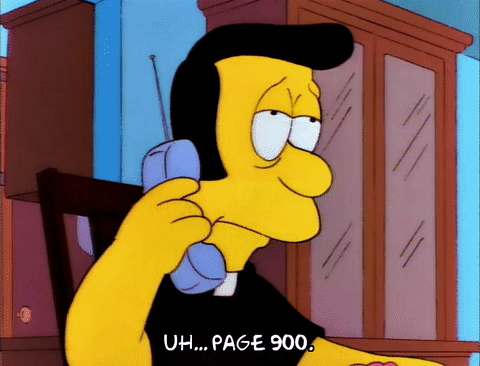It’s ironic that in this modern information age, sites like Amazon still list a “page count” on Kindle e-books. Given the range of devices and font options for e-books, the size of a page is entirely arbitrary. I might need 300 page flips to read a novel on my old Kindle when someone with higher resolution and better eyes could do it in 100. That makes it a pretty poor unit of measurement. It’s like — just as a wild example — using a person’s actual foot to measure distance. We stopped doing that hundreds of years ago, and for good reason.
Page count is obviously meant to help print readers relate, but the fact is even in the print world page count is sketchy. Font size, margins, line spacing, all these things can cause page count for the “same” novel to vary widely. If you’ve ever read a Science Fiction Book Club edition, you know that it’s possible to cram a whole lot of words onto a page.
Even the folks who compiled the Christian Bible knew pages couldn’t be depended upon. They numbered chapters and verses — the actual content — rather than tracking the medium that the content was printed on. That’s why to this day, virtue signalling Jesus fans plaster “John 3:16” all over the place and not “Page 900.”

For my money, the best way to measure a book is with words. Word count describes the length of a book, regardless of how it is presented. A Kindle e-book, a mass-market paperback, a trade hardcover, a large print edition, all have the same number of words.
Of course, readers aren’t as familiar with word count, but it’s been used behind the scenes in the publishing industry forever. NaNoWriMo uses word count to decide when you’ve written a novel: 50,000 or more. The SFWA Nebula awards say a novel is 40,000 words (a novella is 17,500 to 40,000 words, a novelette is 7500 to 17,500, and a short story is under 7500). They don’t use page count. They use words. It’s a proven concept.
So I would encourage anyone who finds themselves in a position to report the length of a book to go ahead and tell people something meaningful. Tell them how many words are in it.
Les Miserables 655,000 words
Atlas Shrugged 645,000 words
War and Peace 587,000 words
The Lord of the Rings 481,000 words
Shogun 429,000 words
Lonesome Dove 365,700 words
Harry Potter and the Order of the Phoenix 257,100 words
Dune 201,000 words
Harry Potter and the Deathly Hallows 198,200 words
Catch-22 174,000 words
Fifty Shades of Grey 155,000 words
Last of the Mohicans 145,500 words
To Kill A Mockingbird 100,400 words
Hunger Games 99,750 words
Nineteen Eighty-Four 88,900 words
Neuromancer 79,000 words
Harry Potter and the Sorcerer’s Stone 77,000 words
Catcher in the Rye 73,400 words
Brave New World 63,700 words
Lord of the Flies 59,900 words
Fahrenheit 451 47,000 words
The Lion, the Witch, and the Wardrobe 36,300 words*
Animal Farm 30,000 words
Of Mice and Men 29,160 words
*Note that my book, The Lesbian, the Bitch, and the Bathrobe has 40,000 words. It’s clearly a much better bargain.


I’m okay with page count, because I’m still a paperback lover first, and an e-book connoisseur out of convenience. Mentally, I page count just carries more meaning for me. What I hate is when Amazon neglects to show the page count, and the author doesn’t note the word count in the blurb, leaving us to go on the File Size. That is the most meaningless statistic going, and has nothing to do with the length of the story.
LikeLike
Page count does have a lot of tradition behind it. File size is a strange statistic to use, isn’t it? It’s like using grams to measure a paperback.
LikeLike